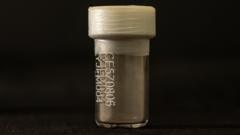The first samples of Moon rock brought back to Earth in nearly 50 years have landed in the UK, courtesy of a loan from China. These rare grains of dust are now securely housed in a high-security facility in Milton Keynes, with scientists receiving their first glimpse. Professor Mahesh Anand, the only UK researcher awarded access to this material, refers to it as "more precious than gold dust."
Anand traveled to China to collect the samples, which will be subjected to rigorous analysis as researchers seek to answer pivotal questions regarding the Moon's formation and the early history of Earth. The dust may contain evidence supporting the theory that the Moon was formed from debris resulting from a cataclysmic impact between Earth and a Mars-sized planet approximately 4.5 billion years ago.
The samples were gathered during China's Chang'e 5 mission in 2020, which successfully returned 2kg of material from a volcanic region known as Mons Rümker. This marked the first lunar sampling mission since a Soviet endeavor in 1976 and positioned China as a key player in the modern space race.
In a notable step for international collaboration, China has provided samples to seven researchers worldwide, allowing for groundbreaking scientific discoveries. Anand described the experience as surreal, referencing the significant advancements China has made in space exploration.
Upon returning to the UK, Anand adhered to strict protocols to prevent contamination while handling the samples. Inside a sanitized lab at the Open University, he depicted the Moon dust as unassuming yet profoundly significant, noting that just 60mg would be adequate for extensive research.
The first to engage with the lunar material will be technician Kay Knight, who has spent 36 years analyzing rocks. Even with her vast experience, this will be her first encounter with genuine lunar samples, and she expressed both excitement and nerves given their rarity.
As the research progresses, samples will undergo testing in highly specialized labs equipped with bespoke machinery, allowing for the analysis of gases and elements present in the dust. Despite the high stakes, Anand hopes that these samples will pave the way for ongoing collaborations between China and international scientists, continuing the tradition established by previous lunar missions.


















